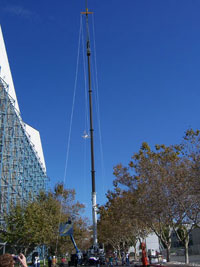NASA’s space technology Olympicsby Taylor Dinerman
|
| The inclusion of a prize for a personal air vehicle seems intended to show that NASA is not entirely forgetting its mission to support the aviation industry, but so far it’s the only non-space prize. |
At the February 8, 2006 meeting of the NASA Advisory Council, they passed out sets of cards praising some historic prizewinners such as Louis Bleriot, Charles Lindbergh, and Burt Rutan, and explaining some of the ongoing Alliance Challenges. Of particular interest are the two challenges intended to begin development of lunar in situ resource utilization (ISRU) technology. The Moon Regolith Oxygen (MoonROx) Challenge is being organized under the auspices of the Florida Space Research Institute (FSRI) , a state-chartered nonprofit organization. The $250,000 prize will go to the team that can extract five kilograms of breathable oxygen from (an FSRI supplied) lunar regolith simulant within an eight-hour period. There will be limitations on the amount of power supplied, the use of consumables, and the total mass of the MoonROx equipment.
This challenge, which runs through the beginning of June 2008, represents a small step towards realistic lunar ISRU. There have been other efforts in the past, notably by Bob Zubrin and the Mars Society, but this, along with the similar Regolith Excavation Challenge being supervised by the California Space Education and Workforce Initiative, is obviously intended to produce a cadre of men and women with hands-on experience in ISRU design and development.
Some of the other challenges in this category are for beam power, tether technology, and a planetary unmanned aerial vehicle, as well as the previously announced astronaut glove challenge. The inclusion of a prize for a personal air vehicle seems intended to show that NASA is not entirely forgetting its mission to support the aviation industry, but so far it’s the only non-space prize. Frankly, it’s more of an afterthought and just brings up once again the question: should the space agency have any role in promoting America’s civil aviation industry?
The Quest Challenges will be the most difficult to properly structure. They will have to be exciting and competitive, while at the same time be difficult enough to be truly educational. To make them into a sort of an easy-to-play game will defeat the purpose. They should be hard enough so that student will have to work hard to win, but not so difficult as to discourage kids from learning to appreciate the nature of the space endeavor.
| There are a couple of dangers to this promising approach: after the prize is awarded the winners will find that they will not have clear and unambiguous ownership of the intellectual property and/or patents involved, and there will be so many of these competitions that “prize fatigue” may set in. |
The Flagship and Keystone prizes are the ones NASA needed special authorization to initiate. Some of the proposals include demonstrating the technology needed for an on-orbit fuel depot for LOX and liquid hydrogen, a micro-reentry vehicle that will carry an egg back from orbit, a solar sail, a human lunar all-terrain vehicle, a low-cost pressure suit, a lunar night power source, a lunar lander analog, and a nontoxic rocket engine. From this list it is obvious that NASA badly want this process to substitute for the usual systems development sequence. This slow and detailed requirements formulation process, followed by contractor bids and design, development, and manufacturing will not produce the technology needed to make the lunar outpost missions, now planned for sometime around 2020 or 2021, a reality. The goal of these missions is to build a base on the Moon, probably near the south pole, and is to today’s NASA what “flags and footprints” were to the agency during the Apollo days.
NASA believes that with prizes, competitors will invariably spend more than the prize itself is worth. After all, Paul Allen spent more than $20 million to win the $10 million Ansari X Prize, and there are lots of other historical and contemporary examples. There are a couple of dangers to this promising approach. The first is that after the prize is awarded the winners will find that they will not have clear and unambiguous ownership of the intellectual property and/or patents involved. The second is that there will be so many of these competitions that “prize fatigue” may set in.
On the whole the agency is to be applauded for grasping this opportunity to reach beyond its usual stable of contractors. Sometime between now and the moment when George W. Bush and Mike Griffin leave office the first of these prizes should—hopefully—be awarded. That will be the time to judge whether this concept is just a passing fad or if it should be a normal part of the way NASA and the rest of the government do business.
